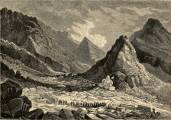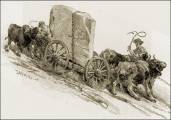


Personal Accounts, Stories, & Creations of People
Working with Stone
|
Please note that there are other accounts of stone workers involved in the stone trade in the state in which they lived and worked. Peggy B. Perazzo |
Walter S. Arnold, Sculptor/Stone Carver, Chicago, Illinois.
“Master Stone Carver Walter Arnold,” video on Chicago Tonight, January 22, 2013 (Wonderful video account)
“Artistry of the Early American Stonemason,” January 22, 2015, presented by Old Stone Houses.
Reinhold Begas, Berlin, Germany – “Inside Bega’s Studio” (located in Berlin, Germany), in The Monumental News, June 1895.
This article contains a photograph of the main part of Reinhold Bega’s equestrian group of Emperor William I, the national monument in Berlin. The “socle on which the group is to stand” was made of granite, although the source of the granite is not specified.
Tom Blatt, Sculptor and Painter, Brooklyn, New York.
Joseph Conrad, Stone Cutter Blog – “The Lost Trade of Stone Cutting,” April 2012
“Joseph Conrad has worked & played in the stone industry for fifty years. From architectural drafting to quarrying to stone installations to founding a stone fabrication business to stone exploring and eventually to sculpture. His blog shares his lifetime of experience. It is meant to make the urban landscape understandable to everyone. He hopes to help provide a sense of place in the urban environment by providing his insights on stone history & fabrication.”
Don Dougan, Sculptor, Atlanta, Georgia.
Early Stone Cutters in Western Missouri, A Research Study From Jones-Seelinger-Johannes Foundation, Butler, Missouri.
Michael Fannin, Stonecarver, Middle Springs, Vermont
George Graham, Sculptor, Batavia, New York
Gary D. Grossman, Sculptor, G. Grossman’s Fine Art - Visit Gary Grossman’s web site to view photographs of California soapstone, Colorado alabaster, Kansas Tuxedo limestone, Kansas Cottonwood limestone, Virginia steatite, Wisconsin sandstone, Nova Scotia blue anhydrite, and Brazilian soapstone.
“The Life of a Quarry Worker,” presented by Stone Mountain Park. (The direct link to this document is no longer available on the Stone Mountain Park web site, although you can still access it on the Internet Archive Wayback Machine: “The Life of a Quarry Worker – Post trip activity.”)
<http://www.stonemountainpark.org/text/quarry%20postactivity.pdf>
This post trip activity document includes the following sections: Background information on Georgia granites and granite-gneisses, Historical Overview (Quarrying on Stone Mountain, the Stone Mountain granite Company, the Stone Mountain Granite Corporation, wages for quarrymen, the stone cutters’ union), Quarrying Methods, Sources, & Crystals, Minerals, and Rocks.
Irish Stonemasons – Rock Fences in the Bluegrass. The information below is taken from the online article: “Rock Fences of the Bluegrass Still in Jeopardy,” by Leatha Kendrick, on the University of Kentucky/Odyssey Online web site maintained by Alicia Gregory. (The book and author referred to below are Rock Fences of the Bluegrass, by Carolyn Murray-Wooley and Karl Raitz.) (The following quotation is used with permission.)
“Eight years ago Karl Raitz’ work on rock fences in Kentucky was instrumental in debunking the myth that these fences were built by slaves before the Civil War. The myth of the fences’ construction, like many myths, was partly true. His investigation traced the real origins of the fences to the work of Irish stonemasons who immigrated into the Bluegrass in the early to mid-19th century. These masons passed the craft along to slaves who became master artisans themselves and further passed the craft on to other black artisans, giving rise to the popular labeling of the rock fences as ‘slave walls.’”
Oleg Lobykin, Stone Carver and Sculptor, East Palo Alto, California
Gary McWilliams, Marble Carver and owner of Stone Arts of Alaska, in Craig, Alaska, & Bellingham, Washington. According to the web site, the stone sold by Stone Arts of Alaska comes from the coastal area islands of southeast Alaska. Visit the web site to view finished pieces made from the Aphrodite Marble, Jupiter Marble, Prince of Wales Greenstone, and many other Alaskan stones. Several of these stones contain fossils. His account of his discovery of Jupiter Marble is especially interesting: “Marble on the Edge,” by Gary McWilliams, Stone Arts of Alaska.
Judd Mullady, Marble Carver, of Haines, Alaska, is the subject of the article “Working with marble, rolling with changes,” by Tom Morphet, in the Chilkat Valley News, Vol. XXXVIII, No. 49, December 11, 2008. (Feel free to contact me if you’d like Judd Mullady’s contact information. Peggy B. Perazzo.) (The original link to this article is no longer available, although you can read the article using the Internet Archive Wayback Machine link: “Working with marble, rolling with changes.”)
<
http://chilkatvalleynews.com/archive/2007-31-4.html>
According to this article, sculptor Judd Mullady has carved marble gravestones for families in Haines and Juneau. He uses local Haines marble which varies from “white, pink or green in color.”
Robin Putnam, Stone Carver, Carthage, Missouri.
Welton Roltz, Sculptor and Stone Carver, Sausalito, California
Stone Carvers – “What is a stonecarver?” – Thoughts by Patrick Plunkett, on the Stone Carvers Guild web site.
Stone Workers & Their Families in American Life Histories – Manuscripts from WPA Writers’ Project (1936-1940), Library of Congress – American Memory.
(From the web site) “These life histories were compiled and transcribed by the staff of the Folklore Project of the Federal Writers’ Project for the U.S. Works Progress (later Work Projects) Administration (WPA) from 1936-1940. The Library of Congress collection includes 2,900 documents representing the work of over 300 writers from 24 states. Typically 2,000-15,000 words in length, the documents consist of drafts and revisions, varying in form from narrative to dialogue to report to case history. The histories describe the informant's family education, income, occupation, political views, religion and mores, medical needs, diet and miscellaneous observations. Pseudonyms are often substituted for individuals and places named in the narrative texts.”
The Stonesetters – The Men Who Built the University (Duke University Archives, Durham, North Carolina). This site tells the story of Louis Fara, a native of Frugarola, Italy, and the other stone masons of his era who help to build Duke University. Click here for information on Duke Stone.
“July 16, 1990 marked the end of an era in the history of the construction of Duke University. On that date Louis Fara, a native of Frugarola, Italy, and the last of the original stone setters who skillfully laid the Indiana limestone trim on West Campus, died...Fara was representative of a group of laborers whose unique background and contribution will be acknowledged as long as eyes gaze upon Duke's majestic Gothic arches. The laborers' background and their sense of accomplishment have to be pieced together from scattered published interviews. Fortunately, their names are familiar, for many remained in Durham to raise their families. Six decades after the completion of West Campus the city telephone directory still lists the Italian names of Fara, Ribet, Ferettino, Citrini, and Berini. In addition, Giobbi and Greppi worked the stone as well as the highly respected stone workers Macadie and Brown. They worked along side native blacks and mountain whites who had also migrated to Durham in search of steady employment during severe economic times.”
“What French Sculptors Think of American Sculptors” (in 1895), in The Monumental News, May 1895.
Commercial use of material within this site is strictly prohibited. It is not to be captured, reworked, and placed inside another web site ©. All rights reserved. Peggy B. and George (Pat) Perazzo.

